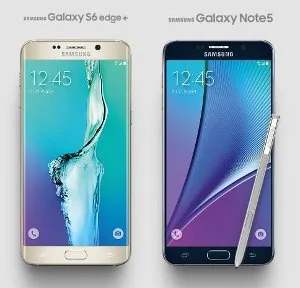Makers of eReaders, especially Amazon, are still selling a lot of eReaders; and makers of tablet PCs are still selling a lot of tablet PCs. But sales of eReaders have been stable for years and sales of tablets are now declining.

Smartphones with really big screens (phablets) are a popular niche, with the new Samsung S6 edge+ and Galaxy Note 5 both having 5.7″ displays with 2560 x 1440 pixels. (Why carry a phone and a tablet when you can just carry a phablet, assuming you also carry a purse or have really big pockets?) But even though phablets occupy a popular niche, it is a niche and not the main stream.
Is there any segment of the portable computing devices market that is actually exciting consumers? There is. Years after some of us predicted it was going to happen, sales of combination tablet-notebook PCs (two-in-ones) have finally started to surge. (Why carry a laptop and a tablet when….)
Beyond two-in-ones, what can we look forward to that will get people excited about portable-computing hardware again? It just might be flexible OLED displays. Flexible OLEDs are currently used in a few products, such as the Samsung Galaxy Edge phones, but they don’t result in products that are flexible. (The GS6 edge is no more flexible than the GS6, which has a “rigid” glass-based OLED display.)
But Samsung and LG are making substantial investments to increase their manufacturing capacity for flexible OLEDs (and Chinese rivals Tianma and BOE are investing in glass-based OLED manufacturing). What we need is not only good, inexpensive flexible OLED manufacturing technology, but also the development of needed ancillary technologies and creative product designers that will use those technologies to create compelling products. (Will the old-saw technology demonstration of pulling a flexible display out of a pen-shaped housing like a window shade still excite people? Doubtful. It’s easier to pull your phone out of your pocket to get a display of roughly the same size.)
Two things we definitely need in addition to flexible OLEDs are flexible batteries and flexible pixel-switching backplanes.
All of this is coming, eventually, but the hardest part will be designing products with flexible displays that fully engage consumers by satisfying not only their wants, but also their needs. On the industrial side, it’s easy to see applications for “flex-once” or “flex-a-bit” displays. On the consumer side, “flex-a-lot-and often” displays, while the most exciting to the display community, can still feel like a solution looking for a problem.
That’s where brilliantly creative product designers come in. At first, Samsung and LG will be meeting pent-up demand for flexible OLEDs in flex-once applications. Shortly thereafter, those exciting new products will be needed to absorb the increasing supply of flexible displays. Are product designers up to this challenge? I’m not yet sure, and I’m very interested in reading your comments. – Ken Werner

